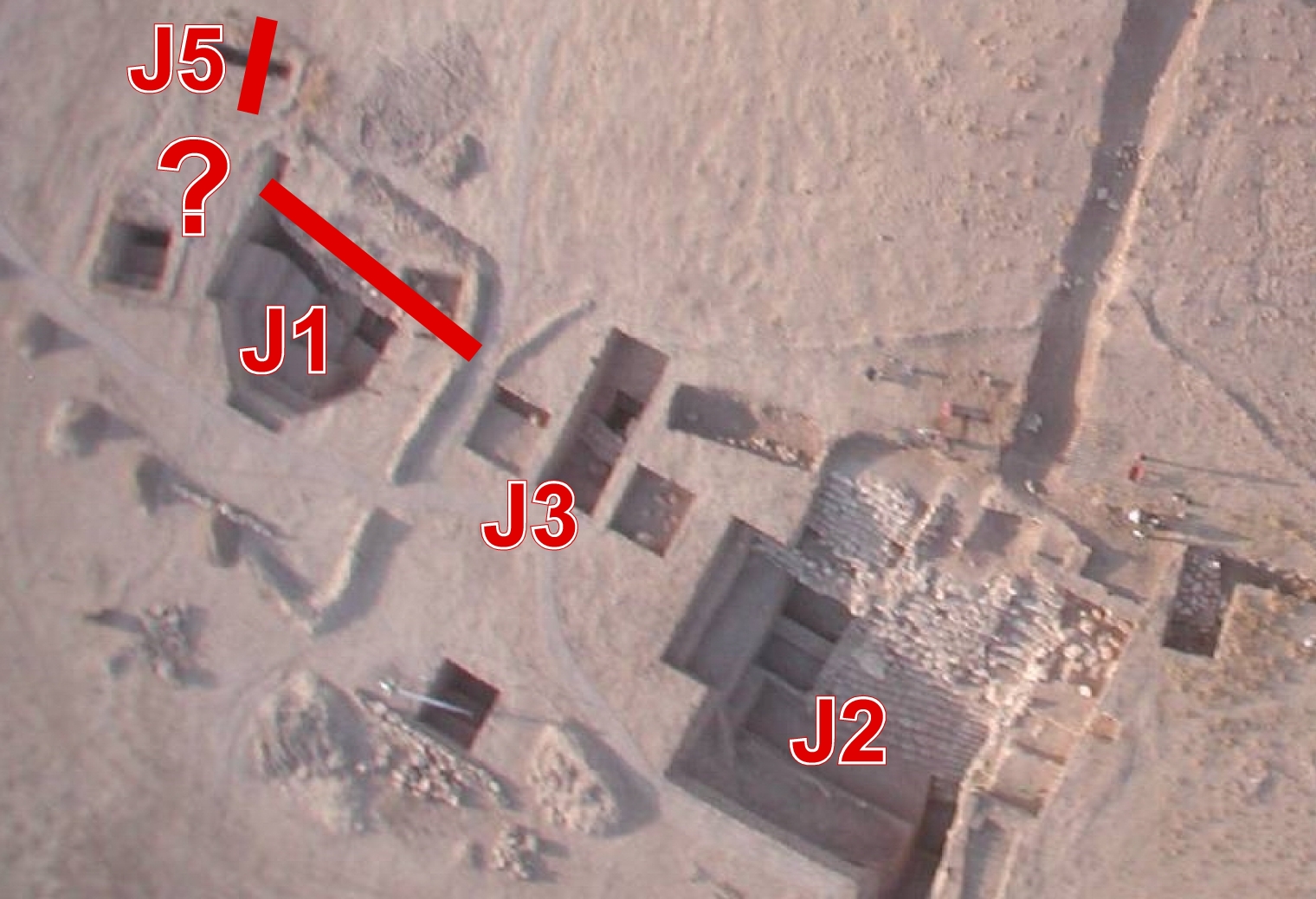For full bibliographical information see Front Matter.
The book for J5 was initiated in 2008 when western loci of unit J1 which subsumed the revetment wall were spun off and combined with an excavation of new loci to the north and west. These new loci had been identified by geophysical survey as possibly containing additional monumental stonework near the tell surface.
Back to top: Preface
Aims
Earlier excavations in J1, J2 and J3 had shown the existence of an imposing wall which delimited the temple terrace at its southern end, serving both as a retaining wall for the terrace itself and as a revetment wall that marked the edge of the wide plaza fronting the terrace.
The major aim of J5 was to explore how this wall continued at the eastern end, in particular since the hypothesis had been advanced that the terrace may have had an oval shape as known from southern Mesopotamia (Pfaelzner 2008 "Templeoval").
| 
|
Back to top: Preface
Results
The J5 excavations gave a full answer to our initial question, showing that we had here the northern closure of the Plaza. In other words, the Temple Terrace was not a free standing mound, but was open only to the wide Plaza in the South. Also, the revetment wall made a sharp turn to the north, showing that the overall structure was poligonal rather than oval.
In addition, the excavations opened a significant window onto the later phase of use of the Temple Terrace, the Mittani period, because an alternative access staircase appeared, alternative, that is, to the the monumental staircase in J2, which had been in use form some two millennia. The new staircase, built in the Mittani period, was in response to a shrinking of the overall temple complex, with a change in focus towards the west.
Back to top: Preface
The excavations
The excavation grid consisted of two major components:
a. a regular block of sixteen 5 by 5 squares, and
b. a group of contiguous irregularly shaped polygons which follow and span the revetment wall.
There are several functional sub-units arrayed in time and space within the unit.
Chronologically, the earliest structures excavated so far are a cut stone wall, its stone escarpment, and a pebble pavement extending south and west into unexcavated baulks. (It should be noted that since these structures are at the highest portion of the tell, we expect much earlier structures dated to the fourth millenium and possibly earlier below.) These stone structures were covered by accumulations dated to the Early Dynastic Period. Directly atop these, with no intermediate strata, are accumlations and structures dated to the Mittani Period. Except for scattered Middle Assyrian ceramics, the Mittani material is covered by abandonment accumulations.
Spatially, in all periods the eastern portion functioned as a revetment wall, its glacis and its escarpment through several phases of building and re-building. However, to the west and north, function was time-dependent. At the time of construction the revetment wall and its escarpment were probably associated with structures to the west, yet to be excavated. Later in the EDIII period, accumulations were allowed to cover the escarpment and pavement. During the periods between EDIII and Mittani, the surfaces were kept clean and no build-up occurred. Early in the Mittani period a small stairway was built to access the top of the revetment wall. Later in that period, the entire temple access was shifted from the far southeast to the northwest and a smaller staircase and plaza were built atop the revetment wall.
Back to top: Preface
J5 within its broader setting
To more fully make sense, depositionally and functionally, of the findings in J5 it is indispensable to see them within the wider contexts of the JP digital book: the area of the Plaza fronting the revetment wall of the Temple Terrace has been excavated more or less continuously since 1999, when a trench to link the previously excavated BA Temple to a new excavation of settlements in Area C2 exposed a monumental complex consisting of a revetment wall, a monumental staircase, and an open plaza.
Back to top: Preface
The digital book
This book for J5 was one of the first in the UGR system to be kept fully current with the excavation. (See the chronicle for details). As a result, the final revision for publication was relatively easy, and the number of errors is considerably less than in other books.
Back to top: Preface
The uses of the book
To be able to “read” the J5 digital book, like any other such book, requires a certain familiarity with its structure, although the intent has been to make access to the browser edition as transparent as possible. One will find a detailed explanation of the page layout in the UGR digital book.
For a summary of the main results of work in J5 please refer to the overview within the special “Introduction” to this digital book.
Back to top: Preface